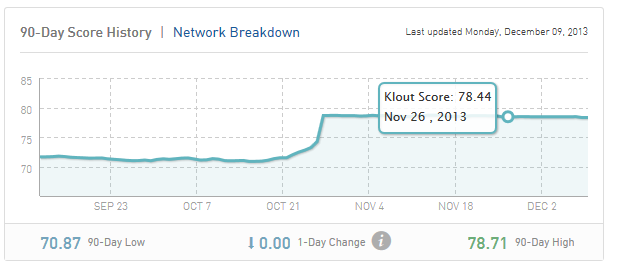How Klout and Kred Differ In Social Measurement
![]()
When providing social media consulting, a question I am often asked is, “Should I use Klout or Kred for my social media measurement?”
My answer is: Both
There are a few differences between them, especially when it comes to real-time measurement. It’s good to understand how the services measure social influence differently and how you can use each most effectively to gauge how your social media marketing is working for you.
Klout
When it comes to social measurement Klout has been the leader since its beginning in 2008; and, is the first company to create a proprietary measurement algorithm on perceived social influence. The challenge of the service is the lack of transparency on how scores are generated. These numbers go up and down daily and often without reason. OR, there might be very little fluctuation even with an increase in activity, then have your score experience a jump. People go on vacation and aren’t as active on social media. Or the reverse could be true where you are very active a few days and then drop off. My guess is that Klout is looking at your social media activity across a period of time, so your score is not in ‘real time’.
If you look at my 90 day graph, you’ll see that things ‘stall’ a bit before moving upward as I increase my reach:

Social networks like Facebook, Twitter, Google+, LinkedIn, Foursquare, YouTube, Instagram, Tumblr, Blogger, WordPress, Last.fm, Flickr, and Bing all contribute to your score. Additionally, Klout takes into account the number of followers and friends, as well as meaningful shares and conversations with Facebook and Twitter at the top of the influence funnel. Scores are calculated based on a 90-day average, and the more active social media accounts you have connected the better.
Kred
Unlike Klout, Kred focuses only on your activity on Facebook and Twitter, with real-time measurement. While you might try to increase your Klout score simply by increasing your tweets, trying this on on Kred will not provide improved results.
Kred is also a social measurement tool and it has similar functions as Klout, but contains different metrics. A Kred user’s score is primarily based on both influence and the communication on your Twitter and Facebook pages. Here is how the company specifically defines the tool’s function:
“We measure Influence by assessing how frequently you are Retweeted, Replied, Mentioned and Followed on Twitter. If you connect your Facebook account to your Kred profile, you get Influence points when people interact with your content on your wall and the walls of others who have registered their Facebook account with Kred. Facebook interactions counted towards your Kred include Posts, Mentions, Likes, Shares and Event Invitations.”
While Klout generates a score of between 0 – 100, Kred provides one between 1 – 1,000. Kred’s transparency shows you exactly how your score is generated right down to each retweet and displays a points value system based on the level of influence of your connections who are sharing your content. Kred even shares its transparency on a scoring guide: http://kred.com/rules.
 Both Klout and Kred remain the two top social measurement tools today. Keep in mind that Klout is still the top dog in how a person or brand’s influence is displayed, but that Kred is also up and coming as it contains current information that does not lag due to a 90 day average. The transparency of Kred is a benefit in that you can see up to the minute how your posts and tweets are performing, which can help you refine your efforts that will be shown later in Klout’s results as well.
Both Klout and Kred remain the two top social measurement tools today. Keep in mind that Klout is still the top dog in how a person or brand’s influence is displayed, but that Kred is also up and coming as it contains current information that does not lag due to a 90 day average. The transparency of Kred is a benefit in that you can see up to the minute how your posts and tweets are performing, which can help you refine your efforts that will be shown later in Klout’s results as well.
Klout and Kred both can be helpful in connecting with other experts in your niche, which can contribute to spreading the word on your business or brand’s content and influence.
Share this article with these Tweetables:
• How to understand the difference between Klout and Kred scores – Click to Tweet
• @SusanGilbert explains how Klout and Kred differ in social measurement – Click to Tweet
• Why is your Klout score not reflecting real-time social activity? – Click to Tweet


0 Comments